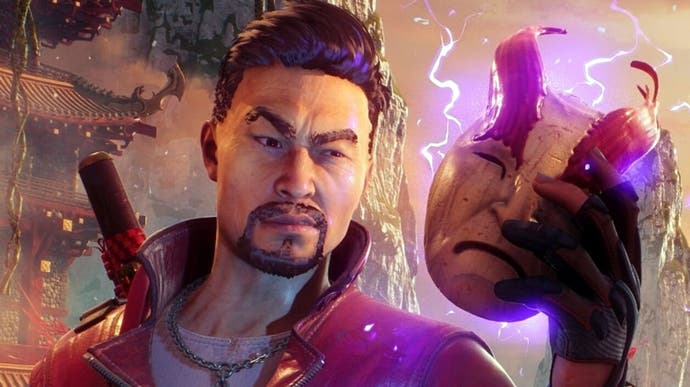Shadow Warrior 3: a great game let down by frustrating technical issues
And there's no native app support for current-gen consoles.
Nine years on from Flying Wild Hog Studios' first reboot of the Shadow Warrior franchise, it's all change with the third series entry. Protagonist Lo Wang's voice is different, the gameplay itself has evolved and crucially - from a Digital Foundry perspective, at least - the engine technology powering the experience has moved on.
The impressive Road Hog engine takes a backseat this time to Unreal Engine 4 - a controversial decision that doesn't quite pay off. Meanwhile, the lack of native current-gen versions of the game is a genuine disappointment - owners of new consoles essentially get accelerated versions of the last-gen game, missing key visual features.
The changes to gameplay are worth focusing on to begin with: Shadow Warrior's 2013 reboot was a fast-paced classic FPS, filled with health drops and secret locations - but with a surprisingly well crafted story and characters you could really care about. Shadow Warrior 2 was a different beast: the base shooting and swordplay improved and the Road Hog engine delivered impressive visuals, but level design and engagement in most of the game took a step back in quality, owing to levels built around tile-based randomisation, Diablo-style. Shadow Warrior 2 may have looked gorgeous, but the base gameplay was marred by turning most of the objectives into something you might find in Borderlands.
Shadow Warrior 3 switches things up still further: shooting and swordplay are radically simplified (two attacks and no parry), with fewer weapons but more focus on those weapons. Perhaps this is to make it work better on a controller with less inputs, but at the same time, these changes also work hand-in-hand with the game's entirely different combat beat, which seems now heavily inspired by the recent Doom games. Essentially, a level is an A to B path where you engage in first person platforming with very light combat in a corridor style where you have very distinct paths that you can traverse through very quickly. These paths then end up in typically circular battle arenas, where enemies spawn in waves and progress is achieved by vanquishing them all. Ultimately, we're looking at tunnel-like movement from arena to arena, but the design is great and the combat itself is very well designed. The focus on fewer weapons works as they're all satisfying to use, while the enemy design is also worthy of praise.
It's a different take on Shadow Warrior, but the move from the Road Hog engine to Unreal isn't as smooth as it should be - literally. While Flying Wild Hog's transition from an art perspective is generally well accomplished, other technical elements fall short. That starts with the move away from real-time engine-generated cinematics to low frame-rate, low quality video, which often interrupt the flow of the game as they used mid-level to introduce new areas, characters and enemy mechanics. To illustrate the extent of this issue, I counted 14 minutes of pre-rendered video sequences in my first 50 minutes of play.
It's also curious how the game starts with a visually disappointing stage: it's only when you reach that second level that you understand that Flying Wild Hog is still capable of producing a great-looking game - and where UE4's advanced rendering features get a workout. The thing is, after playing Shadow Warrior 3 are refreshing myself with the first two games, I'm not seeing the same colossal leap in graphical quality that there was between the first two titles. In fact, the second game still holds up beautifully, with the Road Hog engine firing on all cylinders. Much of UE4's finery seemed perfectly achievable in the older, existing engine.
I also have some reservations with the console renditions of the game, as there's no native support for the latest machines. We were supplied with PS4 code for review, which presents on PS4 Pro at a meagre 1080p resolution and an unsteady, unlocked frame-rate. This is boosted to 60fps when played on PS5, but what you don't get are any improvements to pixel count or improved visual features. Graphics settings appear equivalent to PC's low and medium, missing volumetric lighting - dramatically altering the look of the game, as it's used extensively on PC at the higher quality levels. The console game also appears to have fewer ambient particle effects, pulled in draw distance on lights, reduced (quarter resolution?) textures, lower shadow map quality and reduced geometric density.



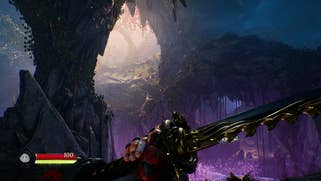

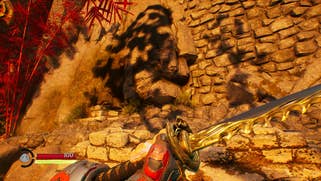
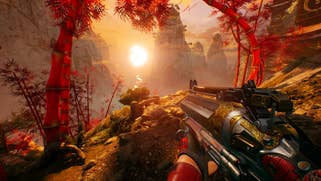
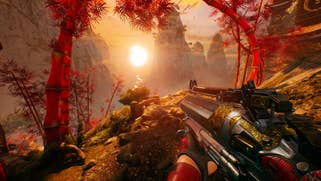
And we have to talk about stutter, my single biggest issue with PC gaming at the moment. Interestingly, PS4 Pro has stutter: a long pause after a video plays, before you can get into the game - not the best first impression (thankfully gone on PS5). However, in common with many, many UE4 titles on PC, there's a properly annoying stutter problem, presumably due to shader compilation, where GPU code is compiled on the fly during play, momentarily pausing the game for fractions of a second.
The amount of stutter and the size of the stutter is egregious in Shadow Warrior 3, and like all games with shader compilation issues, it will decrease over time - compiled shaders are cached for re-use, meaning that the stutter only kicks in the first time the required effect is used. However, what this means is that your first playthrough will be compromised. Excluding videos, the first 33 minutes of actual gameplay saw 82 separate stutters (defined by a frame-time over 33ms). Some stutters are noticeable at 50ms, the length of a blink of an eye. Others can be multiple hundreds of milliseconds long - a split-second pause during play. Now imagine that occurring every 22 seconds on average. Worse still, the stutters are happening on your first play, when you're trying to learn the game.
How can we be sure that shader compilation is the problem? After that first playthrough, I went back and did it all again. Because most of the data had been compiled and cached, those 82 stutters reduced to just six, producing a much smoother game - but the point is that this is the baseline performance I would expect from the game out of the box. As it stands, it's simply not acceptable. Does this issue apply to the console builds? No - a fixed platform means that the developers ship pre-compiled shaders with the game code, meaning that PlayStation 5 powers through at the kind of sustained 60fps PC owners can only dream of. The problem there, of course, is that you're actually playing an accelerated PS4 Pro build, shorn of many of the game's visual features.
In summary, Shadow Warrior 3 is in a strange place. In terms of gameplay, this is the most tightly designed Shadow Warrior to date. It is really good fun and does not overstay its welcome, while the unique set of opponents you have to face really stands out. The new sequel iterates well on concepts and visuals introduced in previous Shadow Warrior games and it looks good and sounds great. However, the technical issues are disappointing: PS4 Pro doesn't run particularly smoothly, while back-compat PS5 works well enough but doesn't look great as it's limited to the last-gen feature set. PC is more disappointing still - the only way to get a smooth experience really is to get someone else to play it through for you first. This isn't an experience unique to Shadow Warrior 3: many, many games do it - including Final Fantasy 7 Remake and Elden Ring to name just two - but we really do need to see this problem addressed and stamped out.
